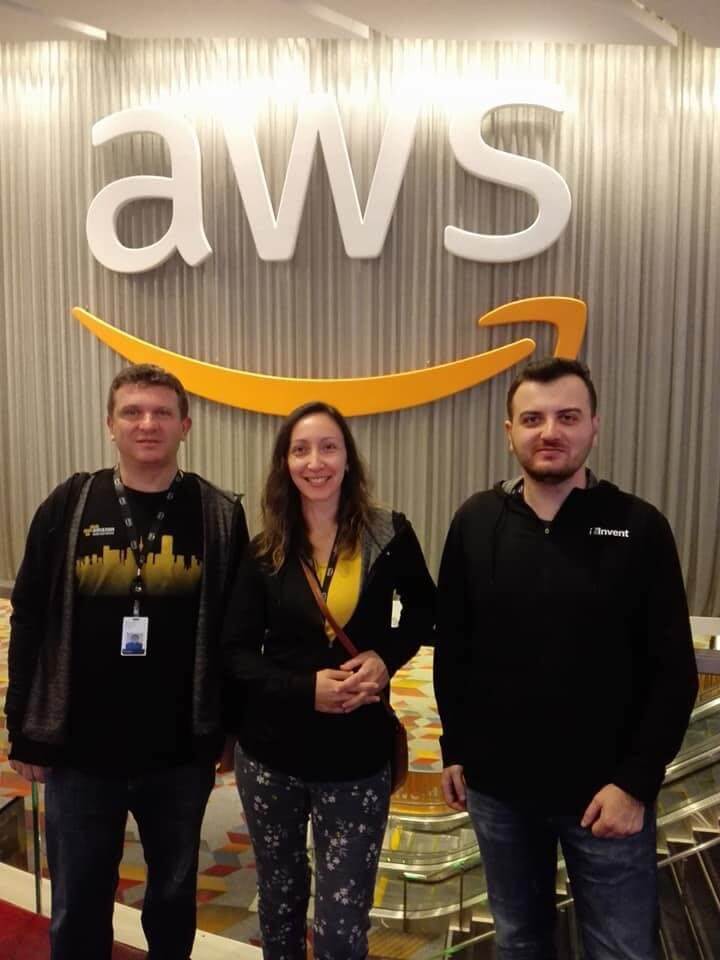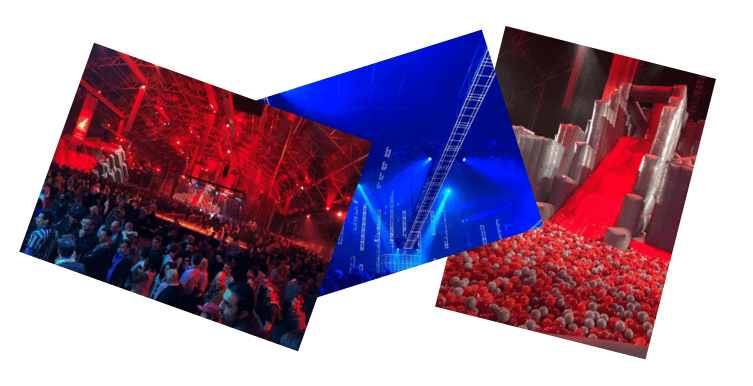The re: Invent, the largest annual AWS conference, is located in stunning Las Vegas, Nevada, USA. Too good to be true. With 45.000 registered attendees, around 5.000 AWS employees, more than 1.000 sessions, boot camps, chalk talks and hands-on labs, certifications opportunities, and many gifts, just imagine the scale of the event. Grandiose hotels like Aria, MGM, Venetian, and Mirage were the locations where crowds of IT people were concentrated.
You are walking on the sidewalk and listening around: serverless, IoT, machine learning, security, big data … OK, we’re on the same team.

Day 1: Monday
The conference is not in full swing yet. Many people will arrive around noon or later, yet the halls are ialready crammed with people eager to learn. We are waiting for an hour in line to register for a session and the chances to get into one are really low. We were rushing between the session’s locations and at the end of the day we managed to attend only 3.

re:Invent is known for many announcements and for us that was like opening presents on Christmas day. We expected the announcements to come on the keynote session from Andy Jessy and Werner Vogels, but, surprise … Conference was opened with announcements mainly centered around media and production. The first one was Amazon Sumerian, a content creation and delivery platform for virtual reality, augmented reality, and 3D applications where gaming or graphics expertise is not required in order to create scenes and actors that will run on popular hardware such as Oculus Rift, HTC Vive and iOS mobile devices.
Second one was a suite of tools to help with media encoding, delivery, security and monetization. The media suite includes the following tools.
- AWS Elemental MediaConvert — allows you to transcode video with broadcast-grade features.
- AWS Elemental MediaLive — a broadcast-grade live video processing service.
- AWS Elemental MediaPackage — reliably prepares and protects your video for delivery over the Internet.
- AWS Elemental MediaStore — a storage service optimized for media.
- AWS Elemental MediaTailor — providers insert individually targeted advertising into their video streams without sacrificing broadcast-level quality-of-service.
This is a really big thing if you like to encode, stream, and employ targeted advertisement at broadcast-level quality only as a service with no infrastructure to maintain.
Day 2: Tuesday
We are diving into the game. The conference is in full swing. All of the attendees are here, Expo was opened with a developer lounge where you might run into Jeff Barr with his purple hair. There was also the AWS Village, content and demo theaters, and plenty of AWS partners and vendors, with stunning products that they offer.
But wait … We had something different in mind for Tuesday. Let’s gamble with our knowledge and get an AWS Certificate. In the end, we are in Vegas. We registered and entered into the quiet room. After 1 hour, here we are, certified and ready to launch ⋮IWConnect as an AWS partner. Now, we can go to the Expo for the fun stuff and a lot of socks.

On Tuesday there were a few more announcements: Amazon EC2 Bare Metal Instances that allow direct access to the hardware, but still have the benefits from Elastic Load Balancing, Auto Scaling, CloudWatch, AutoRecovery, and many other cloud advantages. The next one was Amazon GuardDuty, powered by machine learning, which allows it to turn on world-class monitoring backed by a multitude of public and AWS-generated data feeds. With this information, you’re able to build your own Lambda functions to remediate issues, triggered by GaurdDuty.
Day 3: Wednesday
The day started with a keynote. Andy Jessy’s (AWS CEO) keynote is traditionally filled with numerous major announcements. He started his keynote with ‘Everything is everything’ and I’ll try to cover as much as possible from the ‘everything’ list:
Compute announcements (AWS Fargate and Amazon EKS)
AWS Fargate – This is one of my favorites. Finally, we have serverless containers. One of the primary differences between serverless and containers on AWS has always been a fine line of infrastructure required to run containers. Now, with Fargate, much like Lambda, you can run containers without having to worry about the underlying infrastructure. AWSome.
Amazon EKS – Amazon Elastic Container Service for Kubernetes, which allows you to launch a Kubernetes cluster much like ECS, with all the functionality of and compatibility with Kubernetes.
Database (Aurora, DynamoDB, Neptune)
Amazon Aurora Serverless – yes, SERVERLESS Aurora means, that as your database load increases and decreases, AWS will add or remove database instances respectively from a pool of capacity. Using this model, Amazon is able to maintain constant storage while making compute elastic.
Amazon DynamoDB Global Tables and Backup/Restore – AWS actively listens community and now … we have a multiregional database. DynamoDB has ability to create global tables with multi-master write in DynamoDB. This feature allows you to replicate data across two or more regions as well as write and read in any of those regions. AWS also added the ability to create on-demand backups and we are waiting for point-in-time restores in the near future.
Amazon Neptune – graph databases become popular especially when you are trying to build queries around complex relationships and using a traditional RDBMS is complex or not performant enough. Amazon Neptune will support the following graph models: Property Graph and W3C’s RDF with both of their query languages, TinkerPop and SPARQL. Neptune is currently in preview.
S3 and Glacier Select – S3 is a natural choice for data lake implementations. With tools like Athena, Redshift, and EMR you can query and consume that data. But you usually need only a piece of that large object in your S3 bucket. With the S3 selection, this is now easy and available for Glacier too. This is currently only available in preview.
Machine Learning and AI
One of the buzzwords was Machine learning and AI, so AWS services announced Rekognition, the AWS image recognition service, and added the ability to analyze videos with the new Video Rekognition Service. AWS also added the ability to ingest huge amounts of video through a new service called Amazon Kinesis Video Streams.
AI is taking the high road through three services called Transcribe, Translate and Comprehend. Transcribe and translate are self-explanatory, but Comprehend can be explained as a service with the ability to classify or catalog datasets using machine learning.
Amazon SageMaker – AWS is talking about AI, natural language processing, and data analyses. So, I’ll need some data scientist or PhD for machine learning. But, AWS was thinking about that one so they introduced SageMaker which makes machine learning available and usable to any developer or data scientist. SageMaker gives a fast ramp-up into machine learning by creating a system of common use cases and examples that can be tweaked as needed.
IoT
Two services were announced for management and security. The first, AWS IoT Device Management, allows users to manage fleets of IoT devices including onboarding, organization, monitoring and remote management. The second is AWS IoT Device Defender. Defender is designed for continuous auditing, real-time monitoring and alerts, and fast investigation and mitigation for IoT devices at scale.
Day 4: Thursday
Here he comes, Werner Vogels, CTO and VP of Amazon, in charge of driving technology innovation within the company. He has PhD in computer science supervised directly by Andy Tanenbaum. But before everything to happened, Werner studied radiology, both diagnostics, and therapy. So, never say never.
While Werner didn’t announce as many products as Andy, the content for the keynote was fantastic. In an epic three-hour keynote, Werner made out some really good points about “21st Century Architectures, re: Imagined”. I’ll summarize just some of them:
- The six principles of AWS Well Architected are:
- Stop guessing capacity needs
- Test systems at production scale
- Automate to make architectural experimentation easier
- Allow for evolutionary architectures
- Drive your architecture using data
- Improve with the help of Game Days
- The future will be more human-centric and the main interface will be voice driven
- Protecting your customers should be your #1 priority
- You need to protect data in transit and at rest.
- Security is everyone’s job now, not just the security team’s
- Test, test, test
- Galls Law holds that “A complex system that works is invariably found to have evolved from a simple system that worked “. But complex services managed for you allow you do to less and less so you can focus on the business logic that you are writing.
- And one that I really liked is that in the future, all the code you ever write will be business logic.
Warner’s keynote had several remarkable guests, but what I found really interesting was the speech on Nora Jones, senior chaos engineer at Netflix and co-author of Chaos Engineering, Building Confidence in System Behavior Through Experiments. She was talking about a test approach to the software and this one is still stuck in my head:
“You may be thinking you need more chaos in your life. And you absolutely do. Chaos doesn’t cause problems, it reveals them. Ask not ‘What happens if this fails?’ but ‘What happens when this fails?’”.
Warner made several announcements about API Gateway VPC Integration, Lambda Concurrency controls, increased memory capacity of Lambda functions to 3GB and added 2 new support languages, Go and .NET Core 2 (pre-announcement).
Alexa for Business takes the great things about Alexa and applies them to the business environment. Imagine walking into a conference room and asking the room to “Alexa; setup for ⋮IWConnect team meeting”; and it immediately knew to dial the video conference with correct meeting ID and turn on the projector.
AWS Cloud9 – With this announcement developers are REALY happy. Finally, Lambda functions debugging is coming out of the box. It was a little over a year ago that AWS bought Cloud9 and now Cloud9 is a first-class citizen and available in the AWS Console. Cloud9 already supports many languages such as JavaScript, PHP, Python, Go, and many more.
Ok, we have plenty of tools, good directions, and many new friends, so let’s go for a party. Certification Appreciation party was the warm-up zone and re: Play was the ultimate playground this year with DJ Snake from France. Lot of games, drinks, food, and music … We met Ryan and Sam from CloudGuru. Yei.

Day 5: Friday
Exhausted… Let’s get into several sessions that we’ve missed during the crowded days. We returned to the hotel to pack all the nice stuff that we got from the Expo, leave thanks messages about all the great days before, and hope to come back again next year.
Ops … I was going to forget this one. re: Invent food. Thank you, AWS, for all the great cuisine that you provided for us. It was completely delicious.
Now I’m going to log into my console and try out the new services

